 A TRIBUTE TO KELLY AIR FORCE BASE (As published in the Congressional Record) Seventy-four years after Travis, Crockett and Bowie manned the battlements at the Alamo, Lieutenant Kelly’s death caused the Commander at Fort Sam Houston to call a halt to flying at the Post. Aviation didn’t return to the Alamo City until November 1915, when the First Aero Squadron arrived from Fort Sill, Oklahoma. It did not stay long. In March 1916, the Mexican Revolutionary leader, Pancho Villa, attacked Columbus, New Mexico, and the First Aero Squadron, commanded by Foulois, joined a Within 18 months, Kelly was the largest aviation training, classification and reception center in the United States. With the end of the war to end all wars, Kelly Field was consumed by the lethargy that follows most armed conflicts. The United States adopted an isolationist attitude and military aviation lapsed into a period of near hibernation. Aircraft that had been built for war were now turned to barnstorming and amusement. Throughout the nation aviation camps and depots were closing, but at Kelly Field With the acquisition of more land west of Frio City Road in 1917, Kelly Field was divided into two areas, Kelly Number 1 and Kelly Number 2. While Kelly Number 2 was busy turning out dashing aviators, Kelly Number 1, renamed Duncan Field in 1925, was engaged in a less glamorous task of aviation supply and maintenance. This humble stepchild spawned out of necessity would eventually thrive and go on to become an Air Force logistical giant. By 1935, most world powers were struggling to free themselves from the grip of worldwide depression. In Germany, Adolph Hitler had seized the reigns of power. On the other side of the globe, Japan was running rampid through Manchuria. The clouds of depression were clearing, but clouds of war were rapidly taking their place. Aircrew training at Kelly was stepped up; courses were conducted in nearly every form of military aviation including attack, pursuit, observation and bombardment. Paved runways and permanent facilities sprouted throughout the installation. When Japanese bombs rained on Pearl Harbor on December 7th, 1941, Kelly Field was ready to takes its place as a major cog in America’s war machine. Midway through World War II, Kelly’s logistical role came to the forefront. Pilot training moved to Randolph and other new airfields while an organization known as the San Antonio Air Service Command sought to repair and supply the nation’s aerial fighting force. Less than a year later, the outbreak of the Korean War dropped the temperature of Cold War even further. Kelly personnel labored around the clock to prepare B-29 bombers and Mustang fighters for service overseas. The outdoor lighting lit up the sky at night and became famous as San Antonio’s “Great White Way”.
Although the Berlin Wall came down in 1989, Kelly AFB remained a vital part of American defense of freedom. During Operation JUST CAUSE in December 1989, Kelly was a staging area for troops on their way to Panama and was a reception point for wounded Americans. Less than a year later Kelly’s people worked 24-hour days in support of American and Allied efforts to drive Iraqi invaders from Kuwait in Operations DESERT SHIELD/DESERT STORM. By March 1991, Kelly had sent nine million pounds of munitions to the theatre of operations along with 7,400 tons of other supplies and 4,700 passengers. In April 1999, Kelly employees again were called upon to perform their "logistical magic." Engines were surged to support NATO's efforts to end brutal ethnic cleansing in Kosovo. Even before the end of the Cold War, America's military services saw their budgets grow smaller, and by the early 1990s, people expected to see a "peace dividend" to help reduce the budget deficit and pay for soaring costs of social services. Continuing efforts to cut defense spending by relocating some missions and closing some bases put Kelly and the San Antonio Air Logistics Center at risk. In May 1993, the Base Realignment and Closure Commission added the San Antonio ALC and three other air logistics centers to its list of places to consider for closure. While Kelly escaped the bullet in 1993, it did not do so again. In 1995 the BRAC was determined to close one, or possibly, two of the Air Force's giant depots. Once again, the city and the base marshaled it forces to persuade the commission that this depot was too important to close. Despite heroic efforts, on June 22, 1995, the commission voted first to close the Sacramento ALC at McClellan AFB in California and then voted to close the San Antonio ALC and realign Kelly AFB west of the landing strip to the adjoining Lackland AFB. The ALC would close July 31, 2001. The center had the maximum of six years to relocate its missions and turn over a going concern to the city's redevelopment authority. Center officials used three guiding principles in its planning: the first was continued support to maintain Air Force readiness; the second was taking care of the Kelly work force; and finally, minimizing the impact on the San Antonio Community. Both the city and the Air Logistics Center were determined to make this transition a success. Kelly created the Privatization and Realignment Directorate, headed by Tommy Jordan, to handle the Air Force side of the operation. The city created the Greater Kelly Development Corporation (later Authority) to carry out the strategies and plans to redevelop the base. The group went right to work, signing its first lease for a portion of East Kelly to Rail Car Texas for a rail car repair facility. Less than a month later, aircraft engine giant Pratt & Whitney signed a lease to perform upgrades on the F100 engines. And in November 1997, Ryder International Logistics, Inc. signed a lease for However, the dream to keep all of the Center’s workload at Kelly never materialized. Air Force ran public-private competitions for Kelly's workload. The first went to another ALC. In September 1997, the Air Force announced that Warner Robins ALC won the C-5 depot maintenance contract. Only 200 Kelly workers moved to the Georgia base, but thousands upon thousands of pounds of equipment necessary for C-5 maintenance were loaded on 18-wheelers for the trek to south Georgia. But building 375 didn't remain empty for long. On 20 February 1998, representatives from Boeing, GKDC, and the city of San Antonio signed letters of intent for the lease of five buildings. Workloads at the new Boeing Aerospace Support Center included C-17s, KC-10s and KC-135s for the Air Force and MD-10s for commercial companies like Federal Express. By May 1999, this new center had over 1,300 employees with prospects of more workload and more workers every day. Kelly's other large workload, the Propulsion Business Area, went on the bidding block in March 1998. In February 1999, the Air Force announced that Oklahoma City ALC and its bidding partner Lockheed Martin had won the contract. The news for Kelly and San Antonio was not all bad, however. Early on, Oklahoma City ALC announced it was only interested in Kelly's F100 workload, which left in December 1999. Work on the TF39 and T56 engines, and about 1,400 former Kelly federal workers, would stay at Kelly in building 360 under contract with Lockheed. The rest of Kelly's depot maintenance workload, automatic test equipment, gas turbine engines, and ICBM reentry vehicles for example, moved to the other ALCs between 1997 and 2000. The remaining three ALCs picked up Kelly's materiel management responsibilities beginning with ICBM reentry vehicle items in August 1997 and ending with secondary power systems in June 2001. In the intervening four years, millions of pounds of equipment needed to perform Kelly's various missions left the base for their new homes across the country. Kelly's remaining base operating support transitioned to Lackland AFB, beginning with the 76th Medical Group in October 1999. The final realignment of base support and Kelly's major tenant units to Lackland was completed by April 2001. Meanwhile, the GKDA's vision of a "new Kelly" had taken off. Although the flag came down on the San Antonio Air Logistics Center on July 13, 2001, it was not the end of Kelly's story. Kelly's legacy will live on for generations. Kelly was a place where people from all backgrounds came together to roll up their sleeves and work for a united cause--our country's freedom. For 85 years Kelly AFB made major contributions to the military strength of the United States and the prosperity of San Antonio. Kelly was the largest single employer in San Antonio and South Texas for over 50 years, and year-after-year Kelly was the largest contributor to the Combined Federal Campaign within the city. Kelly was a place where the workers prospered, purchased better homes, and provided family members the resources to pursue more education and more opportunities. Kelly Field provided tens of thousands of civil service jobs, and was the birth and backbone of the Hispanic middle class in the Alamo City. Generations of Hispanic families were employed at Kelly throughout its history, and, today many of the city business leaders and even congressional members have their roots as Kelly families. For decades the men and women of Kelly AFB dedicated their hearts and lives to the service of their country. From its beginnings as a farmer's cotton field in 1916, Kelly became the largest recruit and aviation training camp in the United States during World War I. In the interwar years, Kelly served as the Alma Mata of the Air Corps while its neighbor Duncan Field Following World War I, Kelly became one of the country’s largest logistical supermarkets, supporting the Air Force around the globe. During the most recent conflicts of JUST CAUSE, DESERT SHIELD/DESERT STORM, and Kosovo, the Kelly employees had the greatest logistical support of all the ALCS, shipping more components, more engines, and more munitions. From the beginning of Kelly Field to the end of the San Antonio Air Logistics Center, the logistical impact and support of Kelly and its employees were vital for the United States to be successful in completing the mission. Today, Kelly transitions again, becoming KellyUSA, an industrial, commercial park for the 21st century. But, throughout this tradition of service remains and will continue to be - Kelly Forever! (Posted by Paul Proft using text and selected images from KellyForever.org history pages)
|
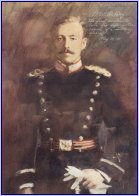 a different kind of warrior made his appearance over the South Texas City of San Antonio. He rode on wings of wood and fabric. In January 1910, on orders from Major General James Allen, Chief of the Army Signal Corps, Lieutenant Benjamin Foulois established a flying field at Fort Sam Houston, Texas. Foulois arrived at the Fort with a Wright flyer, the only airplane in the air service. In April 1911, three young Army officers joined Foulois fresh from Glenn Curtiss’ Flying School at San Diego. Among them was a thirty-year old lieutenant from London, England, George Edward Maurice Kelly. Kelly immigrated to America, enlisted in the United States Army and eventually received his citizenship and gained a commission. Volunteering for duty in the Air Service, he trained briefly with Curtis and then joined Foulois at San Antonio. Lieutenant Kelly’s aviation career would be short lived. On May 10, 1911, he crashed his Curtiss Type-4 Pusher into the brush near Fort Sam Houston’s Drill Field. Lieutenant Kelly became the first American military aviator to die in the crash of a military aircraft. Six years later, one of the nation’s premier flying fields would bear the name of this brave young aviator.
a different kind of warrior made his appearance over the South Texas City of San Antonio. He rode on wings of wood and fabric. In January 1910, on orders from Major General James Allen, Chief of the Army Signal Corps, Lieutenant Benjamin Foulois established a flying field at Fort Sam Houston, Texas. Foulois arrived at the Fort with a Wright flyer, the only airplane in the air service. In April 1911, three young Army officers joined Foulois fresh from Glenn Curtiss’ Flying School at San Diego. Among them was a thirty-year old lieutenant from London, England, George Edward Maurice Kelly. Kelly immigrated to America, enlisted in the United States Army and eventually received his citizenship and gained a commission. Volunteering for duty in the Air Service, he trained briefly with Curtis and then joined Foulois at San Antonio. Lieutenant Kelly’s aviation career would be short lived. On May 10, 1911, he crashed his Curtiss Type-4 Pusher into the brush near Fort Sam Houston’s Drill Field. Lieutenant Kelly became the first American military aviator to die in the crash of a military aircraft. Six years later, one of the nation’s premier flying fields would bear the name of this brave young aviator.
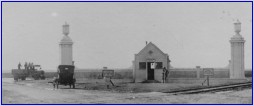 punitive expedition commanded by General John J. Pershing. Within months all its few aircraft were grounded. With World War I raging in Europe, it was clear that American military aviation needed to expand. Foulois, now a major, was called upon to form new squadrons and find a training site. In November 1916, he returned once again to San Antonio. Lacking space to expand at Fort Sam Houston, Foulois looked for another site for an aviation camp, choosing a 700-acre track of land southwest of San Antonio. The land was leased in January 1917. What was once cotton, cabbage, mesquite and cactus, was overrun with men and machines clearing the way for a landing field. On April 5th 1917, the first four planes slid out of the sky to land at the new field. The United States entered World War I the next day. Named Kelly Field in July, the new field was seen training aviators, mechanics, and support personnel destined for duty in France.
punitive expedition commanded by General John J. Pershing. Within months all its few aircraft were grounded. With World War I raging in Europe, it was clear that American military aviation needed to expand. Foulois, now a major, was called upon to form new squadrons and find a training site. In November 1916, he returned once again to San Antonio. Lacking space to expand at Fort Sam Houston, Foulois looked for another site for an aviation camp, choosing a 700-acre track of land southwest of San Antonio. The land was leased in January 1917. What was once cotton, cabbage, mesquite and cactus, was overrun with men and machines clearing the way for a landing field. On April 5th 1917, the first four planes slid out of the sky to land at the new field. The United States entered World War I the next day. Named Kelly Field in July, the new field was seen training aviators, mechanics, and support personnel destined for duty in France.
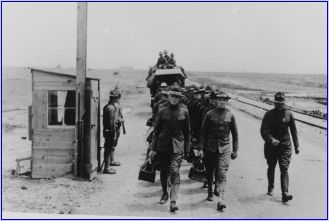 the pace had merely slowed not stopped. For a time, all the active flying groups were stationed at Kelly. Then in 1922, the Air Service restructured its training program, making Kelly home to the Air Service Advanced Flying School. For the next two decades, Kelly would become famous as the alma mater of the Air Corps. During these years, some of aviation’s greatest names pressed the rudder pedals of Kelly trainers. Early graduates of the Advanced Flying School include “lone eagle” Charles Lindbergh; General Curtis LeMay, cigar chopping advocate of strategic air power; and future Air Force Chiefs of Staff Hoyt S. Vandenburg, Thomas D. White, John McConnell and George S. Brown.
the pace had merely slowed not stopped. For a time, all the active flying groups were stationed at Kelly. Then in 1922, the Air Service restructured its training program, making Kelly home to the Air Service Advanced Flying School. For the next two decades, Kelly would become famous as the alma mater of the Air Corps. During these years, some of aviation’s greatest names pressed the rudder pedals of Kelly trainers. Early graduates of the Advanced Flying School include “lone eagle” Charles Lindbergh; General Curtis LeMay, cigar chopping advocate of strategic air power; and future Air Force Chiefs of Staff Hoyt S. Vandenburg, Thomas D. White, John McConnell and George S. Brown.
 In two short years, the workforce expanded from 1,000 to over 20,000. Many were women, Kelly Katies, the Kelly equivalent to Rosie the Riverter. Peace came in August 1945. Kelly Katy went home. The base paused, caught its breath, and then put itself to the task of supporting the most powerful Air Force in the world. On September 18th,
In two short years, the workforce expanded from 1,000 to over 20,000. Many were women, Kelly Katies, the Kelly equivalent to Rosie the Riverter. Peace came in August 1945. Kelly Katy went home. The base paused, caught its breath, and then put itself to the task of supporting the most powerful Air Force in the world. On September 18th, 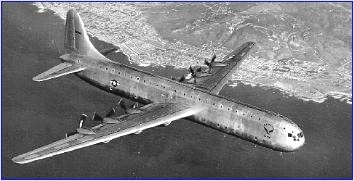 1947, President Harry S Truman signed the National Security Act. Among the articles contained in this legislation was one establishing the Air Force as an independent military service. Duncan Field and Camp Normoyle had been absorbed during World War II, and in January 1948, the field became Kelly Air Force Base. Within a year, the base would once more respond to an international challenge. The Russian bear was putting paw prints all over Eastern Europe. When the Soviets attempted to slam the door on West Berlin, allied air power came to its rescue. Kelly engine maintenance shops operated night and day.
1947, President Harry S Truman signed the National Security Act. Among the articles contained in this legislation was one establishing the Air Force as an independent military service. Duncan Field and Camp Normoyle had been absorbed during World War II, and in January 1948, the field became Kelly Air Force Base. Within a year, the base would once more respond to an international challenge. The Russian bear was putting paw prints all over Eastern Europe. When the Soviets attempted to slam the door on West Berlin, allied air power came to its rescue. Kelly engine maintenance shops operated night and day.  Pratt and Whitney R2000 engines rolled off the production lines destined for installation on C-54 aircraft flying the Berlin Airlift. The Russian bear hug on Berlin was broken after 11-months of Herculean effort by crews, aircraft and dedicated support by San Antonio Air Materiel Area workers.
Pratt and Whitney R2000 engines rolled off the production lines destined for installation on C-54 aircraft flying the Berlin Airlift. The Russian bear hug on Berlin was broken after 11-months of Herculean effort by crews, aircraft and dedicated support by San Antonio Air Materiel Area workers.
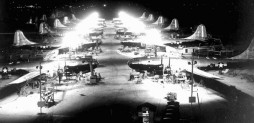 Nuclear deterrent was the “watch word” and Kelly’s people worked in support of the intercontinental B-36 bomber, the first capable of flying anywhere in the world, dropping its nuclear payload and returning home. Its Pratt and Whitney R4360 engines monopolized Kelly’s overhaul facilities for over a decade. A proud yet poignant story revolves around the cargo version of the B-36. The XC-99 transport was the largest cargo aircraft ever built until the advent of the massive C-5A. The huge bird nested at Kelly and from this base of operations set numerous cargo hauling records, but logistics theorists at the time balked at having too many eggs in one basket. Cost of maintaining this one-of-a-kind aircraft grew prohibitive. It now sits next to Kelly's runway; silently watching the C-5s fly the role it pioneered.
Nuclear deterrent was the “watch word” and Kelly’s people worked in support of the intercontinental B-36 bomber, the first capable of flying anywhere in the world, dropping its nuclear payload and returning home. Its Pratt and Whitney R4360 engines monopolized Kelly’s overhaul facilities for over a decade. A proud yet poignant story revolves around the cargo version of the B-36. The XC-99 transport was the largest cargo aircraft ever built until the advent of the massive C-5A. The huge bird nested at Kelly and from this base of operations set numerous cargo hauling records, but logistics theorists at the time balked at having too many eggs in one basket. Cost of maintaining this one-of-a-kind aircraft grew prohibitive. It now sits next to Kelly's runway; silently watching the C-5s fly the role it pioneered.
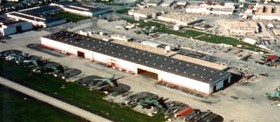 In the early '50s, propeller whine was replaced by jet roar. Boeing B-47s, first operational all jet strategic bombers, began to line Kelly ramps awaiting their turn to pass through the overhaul and modification lines in building 375, at that time the world’s largest hangar. They would be followed by a succession of aerial armament including the B-58 Hustler, the F-102 Delta Dagger, and now the venerable B-52 Stratofortress.
In the early '50s, propeller whine was replaced by jet roar. Boeing B-47s, first operational all jet strategic bombers, began to line Kelly ramps awaiting their turn to pass through the overhaul and modification lines in building 375, at that time the world’s largest hangar. They would be followed by a succession of aerial armament including the B-58 Hustler, the F-102 Delta Dagger, and now the venerable B-52 Stratofortress.
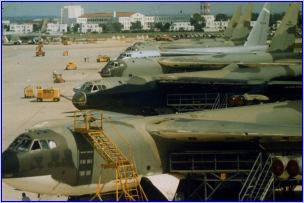 For over forty-five years the B-52 filled the role of manned strategic bombers; and for thirty-six of those years, the San Antonio Air Materiel Area and its successor, the San Antonio Air Logistics Center, strengthened its airframe and modified its offensive and defensive capabilities. In January 1970, a cavern with wings shared the maintenance area with the camouflaged B-52s. It is the world’s largest aircraft, the Lockheed C-5. This enormous cargo and troop carrier, longer than the area covered by the Wright brothers’ first flight, was the most ambitious workload ever assumed by this or any other Air Logistics Center. From the tip of its liftable nose, to the top of its five-story tail, the C-5 was a Kelly management responsibility for over 35 years. Less visible was the vital support given to other aircraft and weapon systems. Kelly personnel managed over half of the Air Force engine inventory, repairing and managing the C-5's TF39 engine and the F100 engine, which powers the F-15 and F-16 aircraft. Kelly personnel also managed engines for the T-37 and T-38 trainers, the A-10 Attack aircraft and C-130 transport. Other members of the Kelly team manage all the fuel used by the Air Force and NASA and monitor all Air Force nuclear weaponry.
For over forty-five years the B-52 filled the role of manned strategic bombers; and for thirty-six of those years, the San Antonio Air Materiel Area and its successor, the San Antonio Air Logistics Center, strengthened its airframe and modified its offensive and defensive capabilities. In January 1970, a cavern with wings shared the maintenance area with the camouflaged B-52s. It is the world’s largest aircraft, the Lockheed C-5. This enormous cargo and troop carrier, longer than the area covered by the Wright brothers’ first flight, was the most ambitious workload ever assumed by this or any other Air Logistics Center. From the tip of its liftable nose, to the top of its five-story tail, the C-5 was a Kelly management responsibility for over 35 years. Less visible was the vital support given to other aircraft and weapon systems. Kelly personnel managed over half of the Air Force engine inventory, repairing and managing the C-5's TF39 engine and the F100 engine, which powers the F-15 and F-16 aircraft. Kelly personnel also managed engines for the T-37 and T-38 trainers, the A-10 Attack aircraft and C-130 transport. Other members of the Kelly team manage all the fuel used by the Air Force and NASA and monitor all Air Force nuclear weaponry.
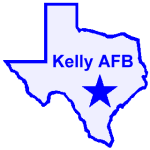
 Over the next year, as workers finished maintenance on the C-5s, Kelly's giant aircraft hangar got emptier and emptier. On 15 September 1998, the last C-5 to undergo PDM at Kelly lifted off the runway, ending nearly eight decades of aircraft depot maintenance.
Over the next year, as workers finished maintenance on the C-5s, Kelly's giant aircraft hangar got emptier and emptier. On 15 September 1998, the last C-5 to undergo PDM at Kelly lifted off the runway, ending nearly eight decades of aircraft depot maintenance.
 The city-appointed authority renamed the base KellyUSA as a way to convey the nonmilitary focus of the burgeoning 2,000-acre industrial and commercial park. By 2000, GKDA was already well on its way to its goal of replacing the civil service jobs lost at Kelly.
The city-appointed authority renamed the base KellyUSA as a way to convey the nonmilitary focus of the burgeoning 2,000-acre industrial and commercial park. By 2000, GKDA was already well on its way to its goal of replacing the civil service jobs lost at Kelly.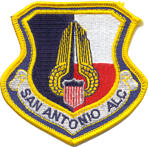 provided repair and supply support for America's small air arm.
provided repair and supply support for America's small air arm.
